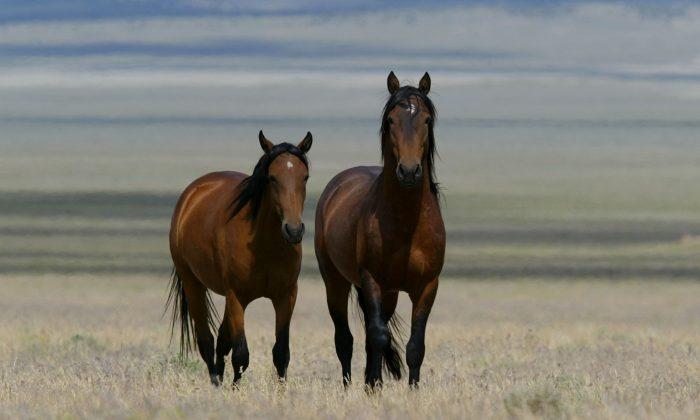An expert in horse population genetics claims to have found laboratory evidence of historical ancestry in samples taken from Arizona’s free-roaming Salt River horses found shot to death on federal land in 2022.
“So far, I can say that there is evidence of Spanish ancestry in the Salt River horses,” Gus Cothran, a retired professor and consultant in animal genetics at Texas A&M University, said in a statement.
In October 2022, volunteers with the Salt River Wild Horse Management Group found dozens of horse carcasses within the Apache-Sitgreaves National Forests in eastern Arizona. All the horses were shot with what appeared to be a high-powered rifle.
The group hired the Texas A&M lab to do a genetic analysis hoping to counteract claims by the U.S. Forest Service that the horses are “feral livestock,” with no protection under the 1971 Wild Free-Roaming Horses and Burros Act.

“That the Spanish influence seems to be widespread in the herd suggests that it could trace back to the founding of the herd unless there were Spanish horses in the area that could have been the source of the Spanish blood,” Cothran wrote.
“Even if that is the case, it would have had to have taken place many generations ago.”
Salt River wild horse advocates say the genetic confirmation is good news that supports the group’s ongoing preservation efforts.
“We’re still trying to collect even more. It was from a sample of about 45 [deceased] horses,” Salt River Horse Management Group president Simone Netherlands told The Epoch Times.
“You can only take the DNA when they die.”

Netherlands said the latest death toll is 43 horses shot and killed since October. However, the unofficial estimate is around 50 horses the group was tracking, including horses still missing.
The Arizona Department of Agriculture is investigating but has yet to report a suspect in the case.
Since the grim discovery, the Forest Service has continued rounding up the herd under a federal management plan and selling the horses at online auctions.
At the same time, the Salt River group’s collaboration has raised thousands of dollars to purchase more than 140 horses and place them in suitable homes.
Netherlands said the genetic evidence suggests the Salt River Alpines horses stem from the Criollo bloodline, introduced by the Spanish in the 16th century.

The Salt River group is raising funds to help defend against a federal lawsuit from the Center for Biological Diversity that seeks to remove free-roaming horses from the Tonto National Forest in Arizona.
In the suit, the center claims the Forest Service failed to abide by the Salt River Horse Management Plan to significantly reduce the forest’s horse population, violating the National Environmental Policy Act (NEPA).
On Feb. 23, the Arizona Department of Agriculture and Forest Service approved the Salt River Horse Management Plan.
The suit claims that the free-roaming herd “greatly exceeds the carrying capacity of the rare desert riparian area where the horses live.”
The CBD estimated 600 horses in the area far outnumber its carrying capacity of 28–44 horses.
Environmental Study Required
The suit argues that the management plan received approval without a federal analysis of the environmental impact from the horses living in the area.“Overgrazing by the horse population has led to, and continues to cause, severe deterioration of the area,” the suit claims.
“For example, range scientists from the University of Arizona observed that they ”failed to document a single perennial grass plant in the area.
The suit claims the horses migrated into the forest in the late 1970s when a cattle grazing program ended due to inadequate forage and environmental damage.

The suit adds that the continued presence of the horses threatens endangered species such as the Yellow-billed Cuckoo, Southwestern Willow Flycatcher, and Yuma Clapper Rail.
The current Salt River Horse Management Area is about 20,000 acres, incorporating the Goldfield and Building areas along the lower Salt River within the forest’s Mesa Ranger District.
Other plaintiffs in the case include the Maricopa Audubon Society, Arizona Wildlife Federation, Arizona Deer Association, Arizona Bighorn Sheep Association, and Arizona Sportsmen for Conservation.
The suit also names Neil Bosworth, forest supervisor of Tonto National Forest, as a defendant in the action filed on April 27.
Wrong Culprits Blamed
Netherlands said the Salt River wild horses have access to 12 miles of the 200-mile-long Salt River and are not the ones ruining the environment.In a press release, Netherlands wrote that the public is “outraged that this lawsuit is blaming the horses.”
“People are outraged because they want to see and watch and photograph the popular wild horses and would not be able to if this lawsuit led to removals.”
Netherlands said the lawsuit seeks to halt the “groundbreaking humane wild horse management programs” and one of the “best-managed herds in the United States.”
“It is the humane management program for these horses that have reduced the foaling rate, from 100 foals a year to just one or two per year, so that the herd can stay balanced with the environment,” Netherlands said.

She said the horses symbolize the American West as cherished historical icons.
Netherlands said the genetic evidence could be helpful in the lawsuit in designating the horses as historical stock, but the outcome “all depends on a judge.”
“It’s a precarious situation for us right now.”





